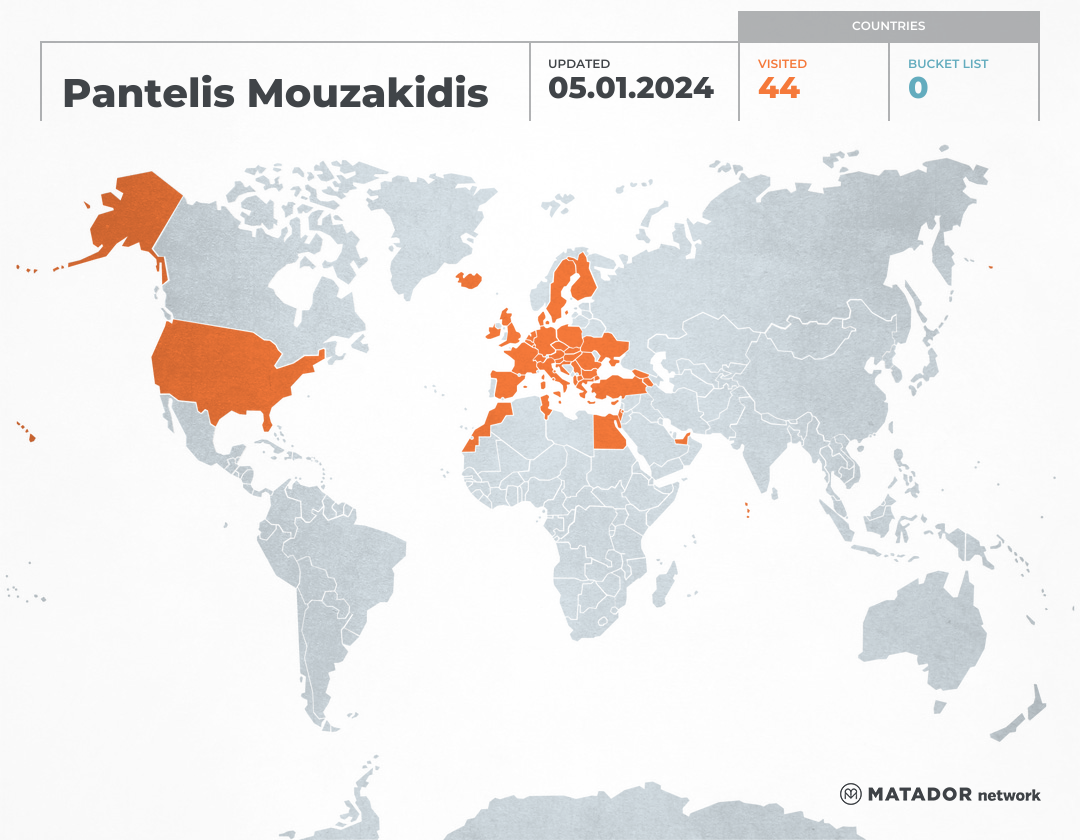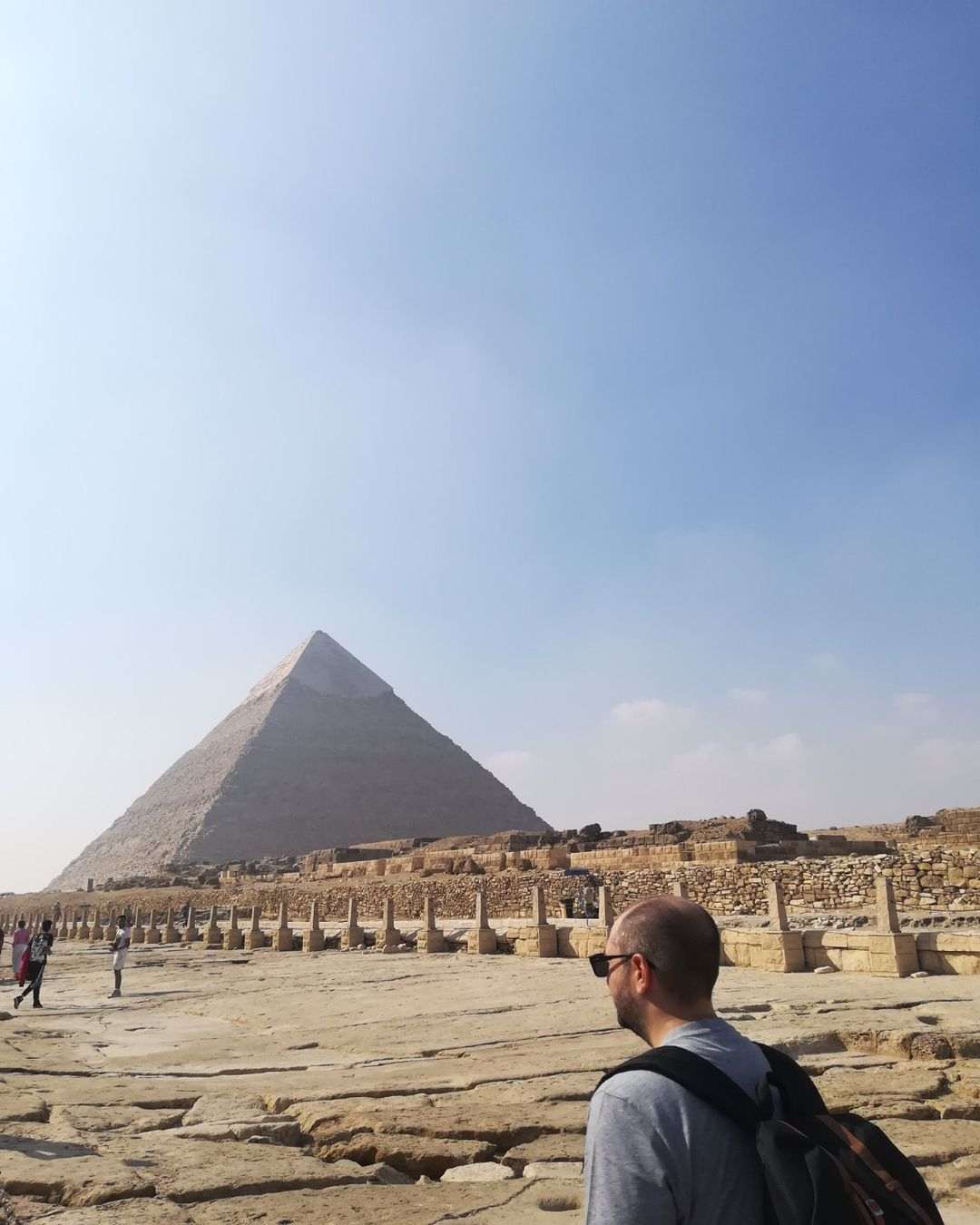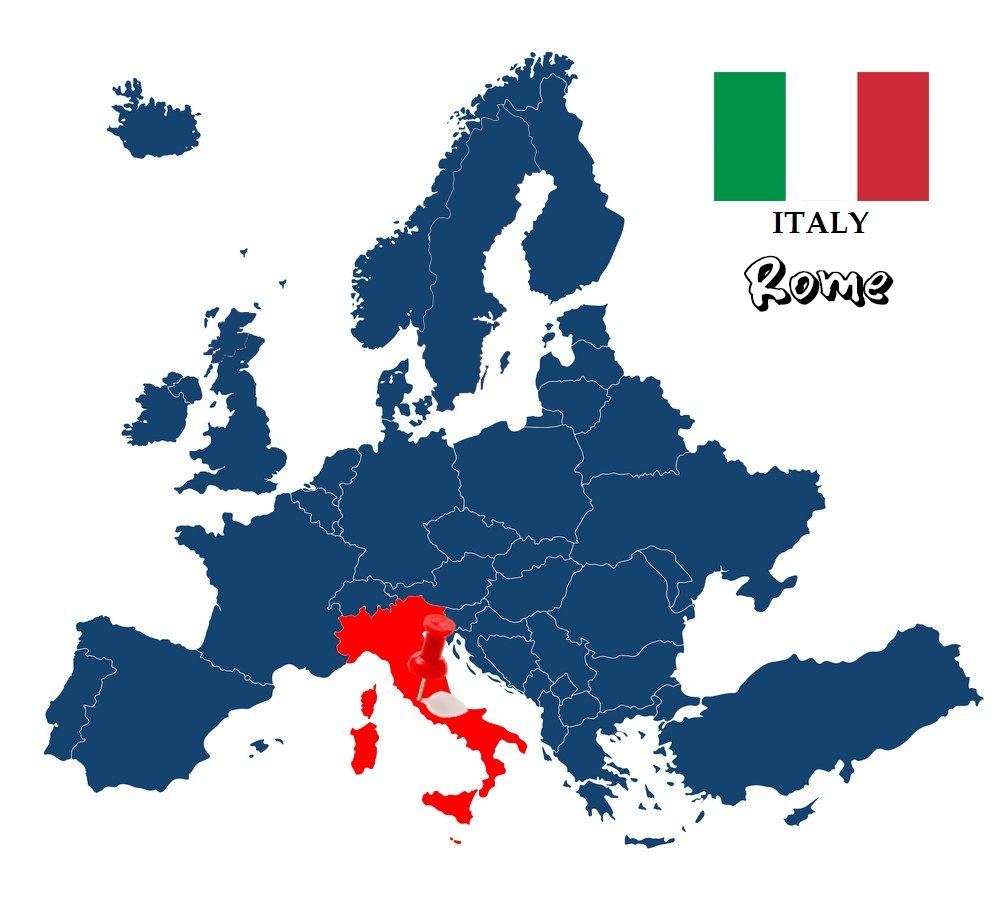
I think Rome is the most "connected" city with Greece, outside Greece. The phrase “una facca, una racca” is not accidental; the two countries have quite a lot in common, making Italy, and especially Rome, the ideal destination for every Greek. Perhaps its location that is very close to our country may play a role, maybe its rich history that is interconnected with ours, maybe its delicious cuisine, its intense fun or its friendly people. I could write whole pages, but I will only settle for these lines, as the magic of Rome is to walk, feel and taste it. And the only sure thing is that if you visit Rome once, you're bound to come back.
A few words about the city
Rome is the capital of Italy and one of the most historic, if not the most historic, cities in Europe. It is the fourth largest city of the European Union in terms of population within the city limits and of course the largest in the country, with 2.874,605 inhabitants. It is located in the central-western part of the Italian peninsula, in Latium, along the banks of the Tiber, while within its borders is the Vatican City, an independent country. Indeed, it is the only existing example of a country within a city, which is why Rome is often defined as the capital of two states. It also has a great history and a remarkable contribution to science, culture and the arts. For this reason, as well as for its numerous and exquisite monuments, and because it has remained the capital ever since the city was founded, has been attributed the nickname "The Eternal City." In fact its historic centre has been listed on the UNESCO World Heritage List since 1980! Rome forces you to fall in love with it and promise yourself that one day you will return. It is no coincidence, the phrase “all roads lead to Rome.” It combines everything in superlative degree, with impressive sights, vibrant nightlife, beautiful walks in the historic centre and of course Italian cuisine. So I will try to present Rome from my point of view and share with you what I think someone should see, visiting the city for the first time.
Fontana di Trevi
The most famous and equally impressive fountain in the world. The unique Fontana di Trevi, was designed by Italian architect Nicola Salvy and completed by Pietro Bracci in 1762. It is dedicated to the elements of water and sea, in the form of the god Neptune dominating the center of the fountain. According to legend, you have to throw a coin over your shoulder and with your back turned into the fountain and will return to the "Eternal City" again! In fact, the amount that falls annually in the fountain reaches one million euros (!) and is used appropriately by the city municipality. During peak hours, there is no empty space, as hundreds of tourists crowding for a photo. So prefer to admire the historical Baroque fountain at your convenience and take the necessary photos at another time, for example early in the morning or late in the evening.
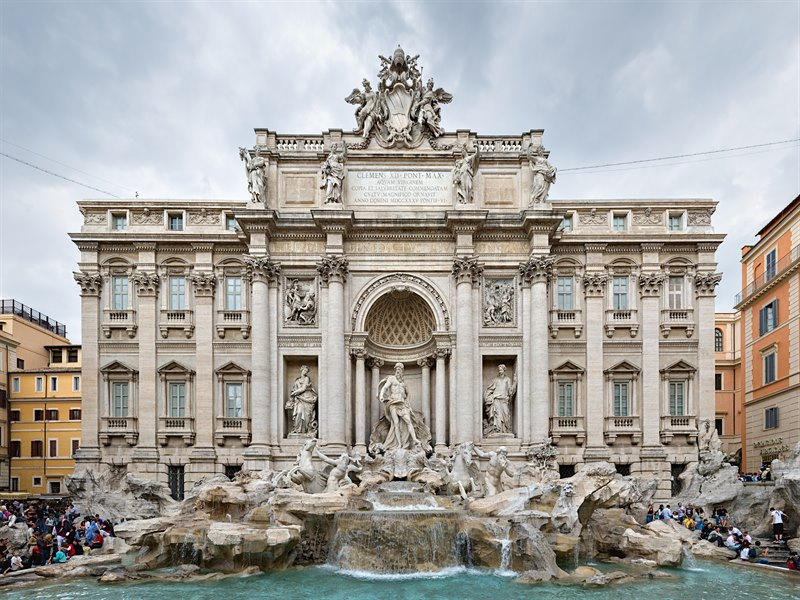
Colosseo
The Colosseum (Colosseo) is perhaps the most impressive building of the Roman Empire and possibly the symbol of Rome! Originally known as the Flavian Amphitheater, the Colosseum was the largest building of its time. The dimensions of the building are stunning, as it is estimated that it could accommodate about 55,000 spectators, which would enter the building through its 80 entrances! Its construction began in 72 AD and was completed in 80 AD, a year after Vespasian's death. At the location that it decided to build the Colosseum, there was an artificial lake and part of Nero's huge park, which also included the Golden Gate (Domus Aurea) and the colossal statue of Nero (the colossus), which gave the giant arena its current name. It had four floors, where spectators were seated according to their social class and used as an arena of death, with gladiators facing each other until a final fall for entertainment. Today, after earthquakes and looting over the centuries, much of it has fallen into ruins, still looking remarkable.
On the side of the Colosseum, do not miss the impressive arch of the Great Constantine (Arco di Costantino). Built in 315 AD, when Constantine the Great defeated Maxentius and this arch was dedicated to him.
Roman Forum
After the Colosseum, a visit to the ancient Roman Forum seems like a must. With many influences from ancient Greece, has been in the past the centre of the political, economic, social, and religious life in Ancient Rome, as is proved by the existence of many temples, arches of triumph and buildings. Today it looks like a messy collection of ruins for the uninitiated, but with some imagination you can travel two millennia back and watch the Roman Empire come to life. The remains of many buildings from different periods are visible, with the forum being filled with buildings central to the life of the societies at the time.
Palatino
Quite close to the Coliseum and the Roman Forum is the Palatine Hill (Palatino), on which according to legend the city was founded by Remus and Romulus. It is a large visiting place, decorated with ancient temples, statues and ruins, which worth a visit. Indeed, the rich people of the city were established here, but also several emperors, hence the word ”palace” (palatino). Some of the most important sights on the Hill are the Palace stadium (Stadio Palatino), the residence of the Emperor Domitian (Palazzo di Domiziano), the pavilion and the gardens of Farnesiani (Orti Farnesiani). The hill apart from its historical interest offers panoramic views across the city. The ticket to the Colosseum, Roman Forum and Palatino Hill costs 12€.
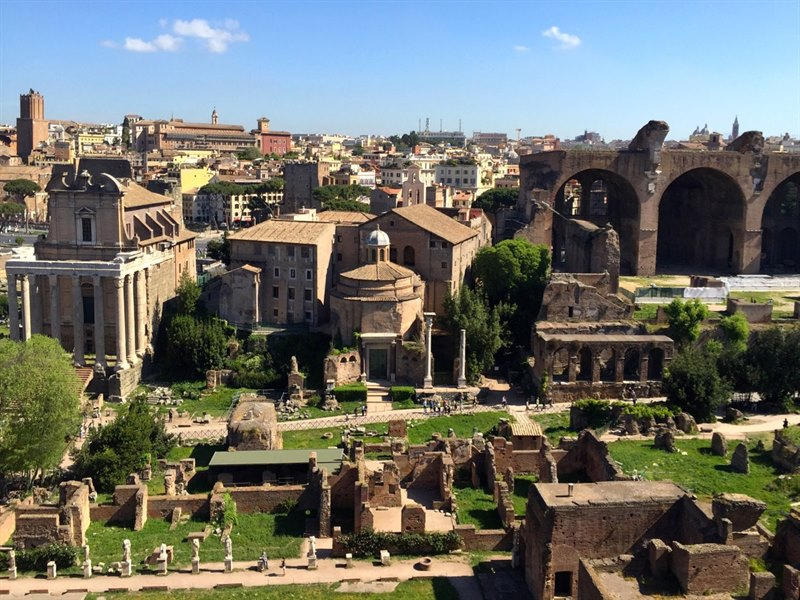
Campidoglio
The Capitoline Hill (Campidoglio) is the second most popular hill, although the smallest of the seven on which Rome was founded, after Palatino. It was the religious and political centre of the city from its establishment, as many important temples were built there by the Romans as the temple of Hera (Juno Moneta), Virtue (Virtus) and Zeus (Optimus Maximus Capitolinus), with the last perhaps is the most important temple in ancient Rome. In 1536, when Charles IV wanted to make a planned visit to Rome, the muddy Capitol Hill was in such a bad condition that Pope Paul III asked Michael Angelos to design a new square, the Piazza del Campidoglio. The construction of the square began in 1546, but only the staircase at the entrance of Palazzo Senatorio was completed when Michelangelo died in 1564. The work was completed only in the 17th century, but most of Michelangelo's plans were implemented.
Today in the centre of the square dominates the Palazzo Senatorio. The name derives from its function as the seat of the Senate until 1870, when it became the seat of the municipality of Rome. It was originally built as an 11th century fortress above the ancient Tabularium and rebuilt in the 13th and 14th centuries. The Palazzo Nuovo and the Palazzo dei Conservatori are also opposite. The second was also the seat of the city government during the Middle Ages. The staircase, which I mentioned above, is decorated with two Egyptian lions, and two large classical statues of Castor and Pollux at the top, while in the center of the square there is a copy of an equestrian statue of Marcus Aurelius.
The palaces today host part of the Museums of the Capitol (Musei Capitolini), which is said to be one of the most interesting in the world. There you will admire a collection, consisting mainly of paintings and sculptures. Some notable works are the lynx feeding the twins Remus and Romulus and the pieces from a giant statue of Emperor Constantine II. Entrance to museums costs 15e.
Pantheon
The Pantheon is located in the historic city centre of Piazza della Rotonda and is one of Rome's oldest and most beautiful monuments. Its history counts over 1800 years of life, since it was originally built in 27 B.C., but it was reconstructed by Emperor Hadrian in 120 AD, being today one of the best preserved monuments of the city. At first it was a pagan temple dedicated to ancient gods and later converted to a Christian church. Its perfection lies in its dimensions (the height is equal to the diameter) and at the fact that it combines many different shapes and forms. The monumental and imposing dome, rising above the circular building, is a unique architectural achievement of the time and used as an archetype around the world. Admission is free.

Castel Sant'Angelo
The castle of St. Angel (Castel Sant' Angelo) is an imposing building on the right bank of the Tiber River with a turbulent history even for Rome's standards. The building functioned first as a mausoleum, then became part of the city wall and later was turned into a fortress before work as a papal residence and finally as a barrack and military prison. Today it operates as a national museum. According to legend, it was named after an angel, who appeared at the top of the castle in the 6th century AD and stopped the epidemic that plagued the city at the time. Inside you will see the highly decorated with many murals pontiff apartments, prisons and a torture chamber. The castle also has a secret corridor, known as “Passetto di Borgo”, which connects the castle with the Vatican, and from the top you can admire the view of the city. The entrance costs 15.5s.
The squares
The Spain square (Piazza di Spagna) is one of the most popular squares in the city and definitely a meeting point for locals and tourists. The combination of the famous staircase, the Spanish steps, an obelisk (La Colonna della Immacolata), a fountain (Fontana della Barcaccia) and a beautiful church (Trinita dei Monti) will tempt you to use obsessively your camera. The area is also famous for young Italians flirting with tourist women sharing roses and many street artists.
The People's Square (Piazza del Popolo) is undoubtedly Rome's most popular piazza and the only sure thing is that you won't have to find it, since everything starts and finish there. In the centre of the square, there is a huge obelisk (Obelisco Flaminio) , while all around you will admire dozens of fountains, like everywhere in the city. At the end of the square, we meet the twin churches, Santa Maria dei Miracoli and Santa Maria in Montesanto, which mark the beginning of Rome's largest and most commercial street, Via del Corso.
Above the Piazza del Popolo there is one of the largest green spaces in Rome, the Vila Borghese. This park has a lake, temples, fountains, statues and various museums, most importantly of them, the gallery Borghese (Galleria Borghese). A building that looks both externally and internally with palace and hosts masterpieces of famous artists, such as Bernini, Canova, Caravaggio, Titian, Rubens, Raphael, etc.. Entry costs 21e.
Another beautiful square that you should not miss is Piazza Navona. It is the largest of the city, as there was in ancient times a sports stadium built in 26 BC. by Emperor Domitian. In the centre stands an impressive fountain designed by Bernini in 1651, representing the longest rivers of the four continents that were known at that time: the Ganges in Asia, the Danube in Europe, the Nile in Africa and the Plata in America. The Shape of the Nile is covered with Veil, because its source was unknown.
Finally, you must make a stop at the controversial Piazza Venezia. Controversial because there is a monument that the Romans do not like at all, since they believe it does not match the rest of the city. This building is the National Monument of Victor Emmanuel II or "Altar of the Fatherland" or "Vittoriano" (Altare della Patria). Unlike the locals, tourists seem to appreciate it, as there are always people ready to capture it.
Trastevere
One of Rome's most beautiful and certainly less touristy neighborhoods is Trastevere. Here you will leave behind the city feeling, the endless attractions and the crowds, and you will be transported to a more bohemian pace, thinking you are in the Italian countryside. It is the place that young people prefer for their fun and locals for tasty, albeit a little pricey, food. Get lost in the picturesque narrow and beautiful classical houses, try an aperitivo, like a plate of cheese and fresh fruit, and have a drink at the dozens of bars in the area. If you are there on Sunday, you will be faced with the Porta Portese an outdoor flea market, where you can find whatever you can imagine!
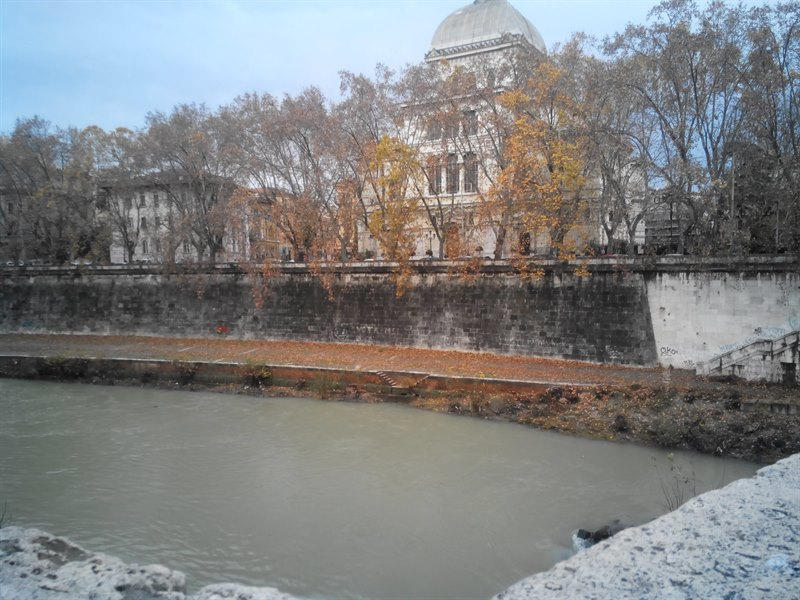
Bocca della verita- Piramide Cestia
The mouth of truth (Bocca della verita) is definitely the funniest attraction in Rome. It is a stone monument with a strange history surrounding it. The myth used to say that if the Romans put their hand in its mouth and lied, it'll bite it. Understandably, hordes of tourists hurry daily to take photos with it and find out if they are ultimately liars! It is located in the courtyard of a Christian Orthodox Church of the Virgin Mary (Santa Maria in Cosmedin) and of course the entrance is free.
You may not be in Egypt, but Rome also has its pyramid. Situated near the gate of St. Paul, it is the only authentic Egyptian pyramid in Europe, the Pyramid of Cestius (Piramide Cestia). The 36-metre-high edifice remains far from unnoticed among the city's completely different architecture and, as a result, imposes an African air on the Eternal City. The entrance costs 5.5e.
Vatican City
Last but not the least, I left the Vatican City. The Vatican is the smallest state in the world and, as I mentioned in my introduction, is the only existing example of a country within a city. Indeed, there are some great monuments (perhaps the largest) of historical and religious interest.
The Vatican Museums (Musei Vaticani), is one of the busiest museums in the world, and you must arm yourself with patience, as the wait in line can take hours. In addition to the endless queues on the tickets, be aware that thorough security checks are also carried out, delaying entry even further. When you enter you will of course be fully compensated, as you will be able to admire the masterpieces of Bernini and Michelangelo, with most important of them the “Cappella Sistina”, as well as other collections of the great Renaissance artists. One day is not enough to see everything, so I suggest you decide in advance what you want to prioritize within the museums. The entrance costs 17e, but the last Sunday of each month, admission is free.
Right next to it is the square of St. Peter (Piazza San Pietro) and of course the church that bears its name. One of the largest, but certainly the most impressive church in the world and seat of the Pope. The Basilica of St. Peter (Basilica Di San Pietro) is a jewel of architecture both internally and externally. It is adorned with dozens of impressive statues, most notably Michelangelo's Pieta and of course gold dominates everywhere. If you are not afraid of heights, climb the impressive dome to admire the panoramic view of the city. With the elevator you will escape around 320 steps, but you will need to take deep breaths, as follow other... 231 (551 in total), to the top. And here the queue is expected hugely, but you will not need to pay for a ticket as the entrance is free.
How to go
Rome has two airports, Fiumincino, the largest in the city, and Ciampino, which mainly hosts the lowcost companies. The cheapest way to reach Rome is by Ryanair (Ciampino), which with proper planning can find tickets starting from € 46 (!) roundtrip. You can also choose a flight by Aegean (Fiumincino) with a stopover in Athens, for a more comfortable flight, from € 140 roundtrip.
Where to stay
Apart from Termini, where the city train station is located and is not considered a particularly well-known area, Rome has many options both in hotels or hostel, as well as in apartments via Airbnb. Do not be afraid to stay beyond the river, as the distances are quite small, and the transport network is particularly good. Personally, I would suggest the Barberini area and more specifically the Hotel Azzurra, which has excellent value for money and is located just 3 minutes from the Trevi Fountain. To those who like to be at the heart of the city, a good bed and breakfast, on Rome's most central street, Via del Corso, is the B&B Corso22.
How to move
A well-known saying goes: 'When in Rome, do as the Romans' and today this translates, at least in practical terms, into a lot of walking. Renting a car would be a very bad idea as in the city centre there is usually a lot of traffic, while parking is difficult to find. Of course, the magic of this city is to walk around and discover its beauty step by step, but for those who need to use public transport, the subway is the ideal solution. Trams, buses and a suburban train are also available in Rome if you want to get away from the city center. Finally, taxis are relatively expensive, while their drivers have the "Greek" bad habit of circling to increase the price.
What to eat
Do you ask? The birthplace of pasta and pizza gives the visitor the opportunity to taste authentic flavors and recipes of traditional Italian dishes. Avoid tourist places and get lost in the narrow streets by choosing restaurants that usually eat only Italians. Try the Italian Carbonara with fresh pasta and taste the delicate dough of traditional pizza, which the locals bake in a wood-fired oven. Casa & Bottega in the historic centre, L'Antica Enoteca in Piazza di Spagna and the Royal Art Cafe opposite the Colosseum, are some good enough restaurants to introduce you to Italian cuisine. Even in winter, don't forget to eat the famous gelato (ice cream), which you will find in many flavors and variations, in scattered parts of the city. The best we tried at Gelateria Valentino. Finally, it's inconceivable to leave Rome without tasting the traditional Cappuccino and savor the famous Tiramisu, a good choice to make, is the Roma Beer Company at Campo de Fiori.
Useful information

In Italy we travel with a passport or a new type of Police identity card, where the information is written in Latin characters.
In Rome the language used is, of course, Italian, but most of them know English, and even those who don't know are willing to help even with gestures.
The currency of the country is the Euro.
Rome is one hour behind Greece (GMT +2).
The transition to and from Rome's airports is simple and lies in your wishes. There are three bus companies Terravision, Sitbus and Schiaffini, which take you with 4-6e downtown. Also from last year there is the choice of the State Bus 720, which is cheaper (1.5e) but of course it takes longer. Finally, if you are with company of more than 3 people then it is advantageous to get a Taxi that costs 15e.
The Greek Embassy in Rome is located at 4 Viale Gioacchino Rossini Street and its phone number is +39 06 853 7551.
Take care of your personal belongings as in Rome there is an increased risk of pickpockets and other petty criminals.
The climate of Italy is quite similar to that of Greece, so there are mild winters and hot summers. An ideal visiting period is autumn or spring.
Recommended excursions→ Naples, Pisa, Florence

If this article seemed interesting or contributed to your quality information, then you can like my facebook page: o_thessalonikios or follow me on instagram!
Mouzakidis Pantelis





